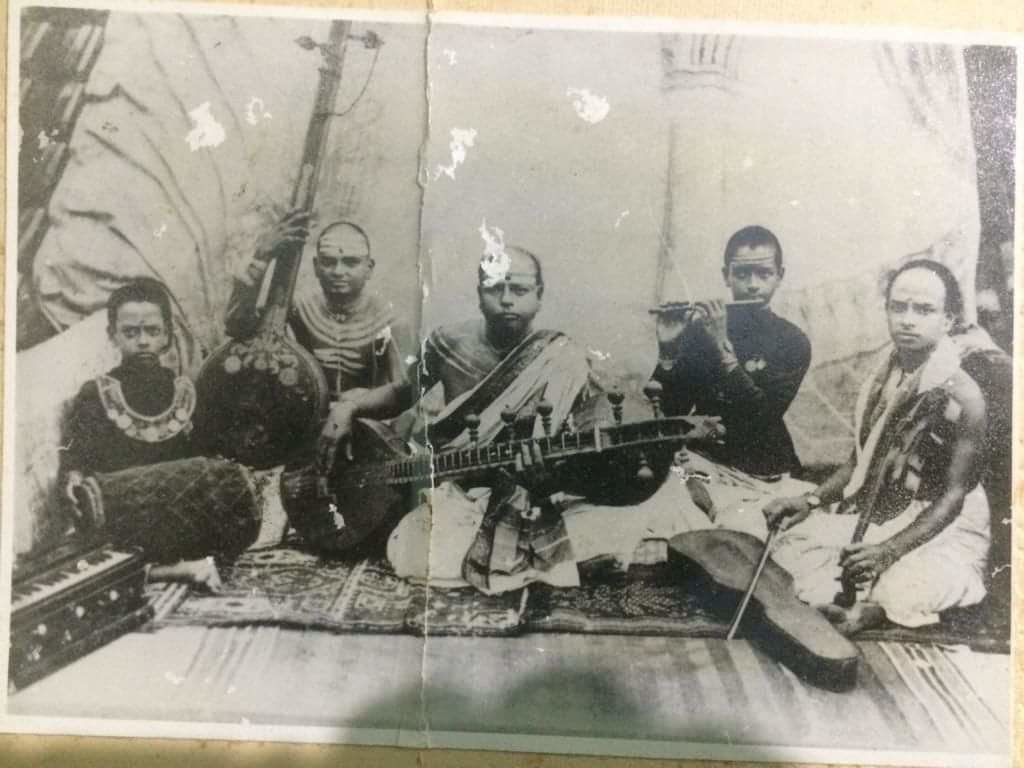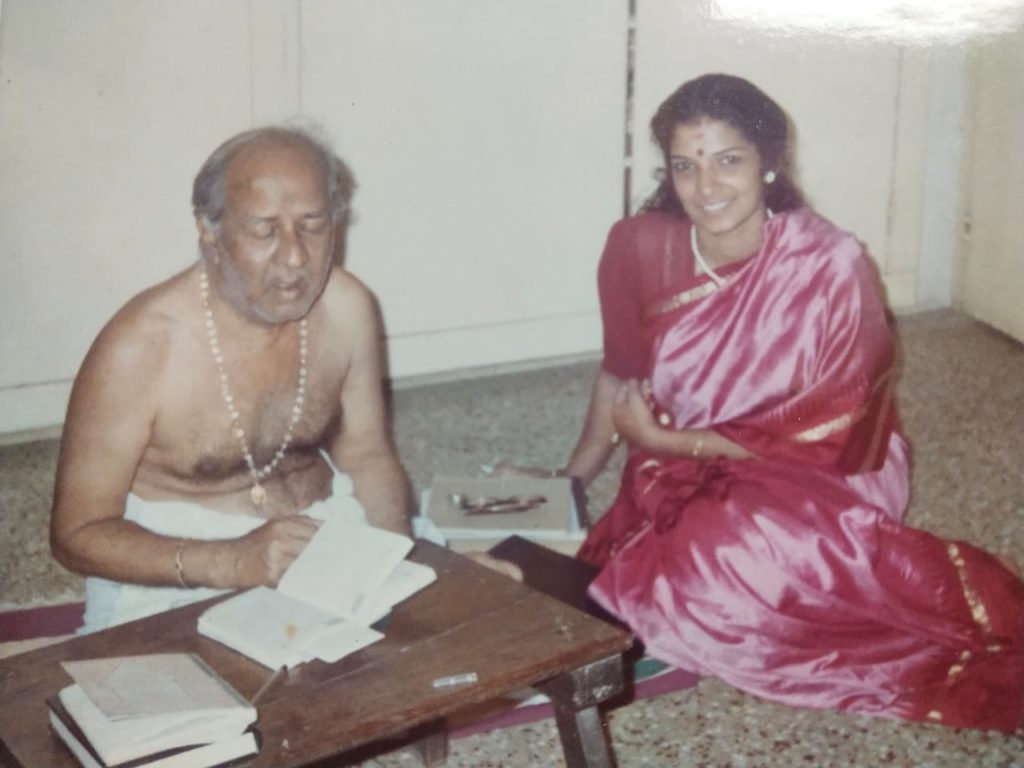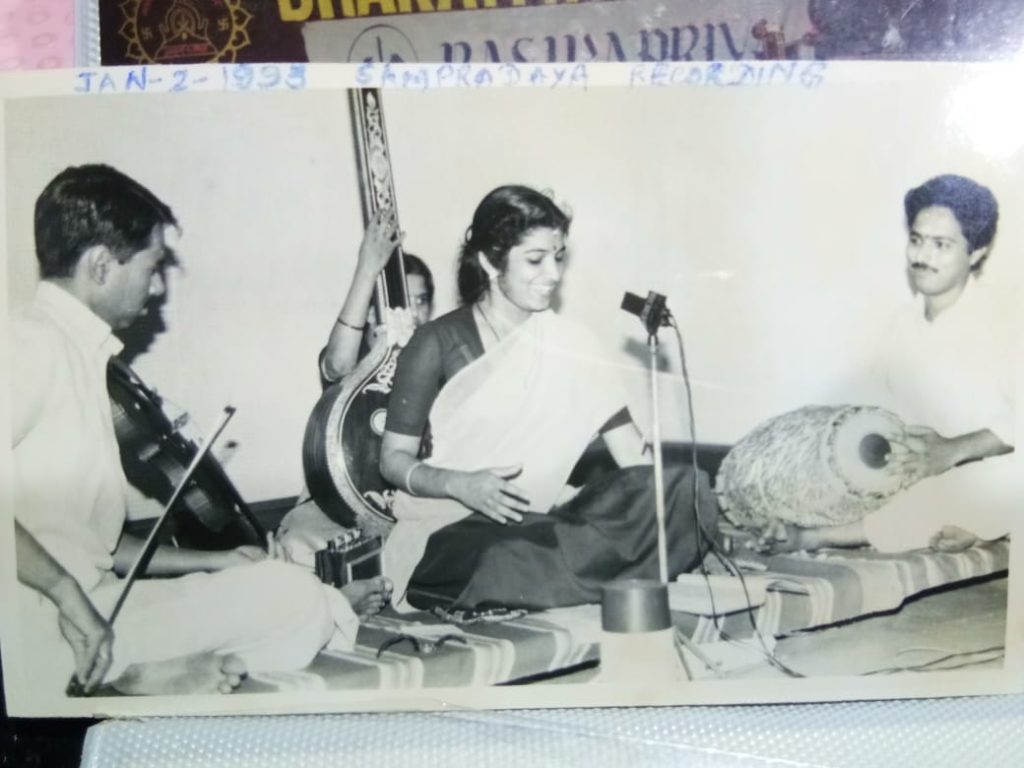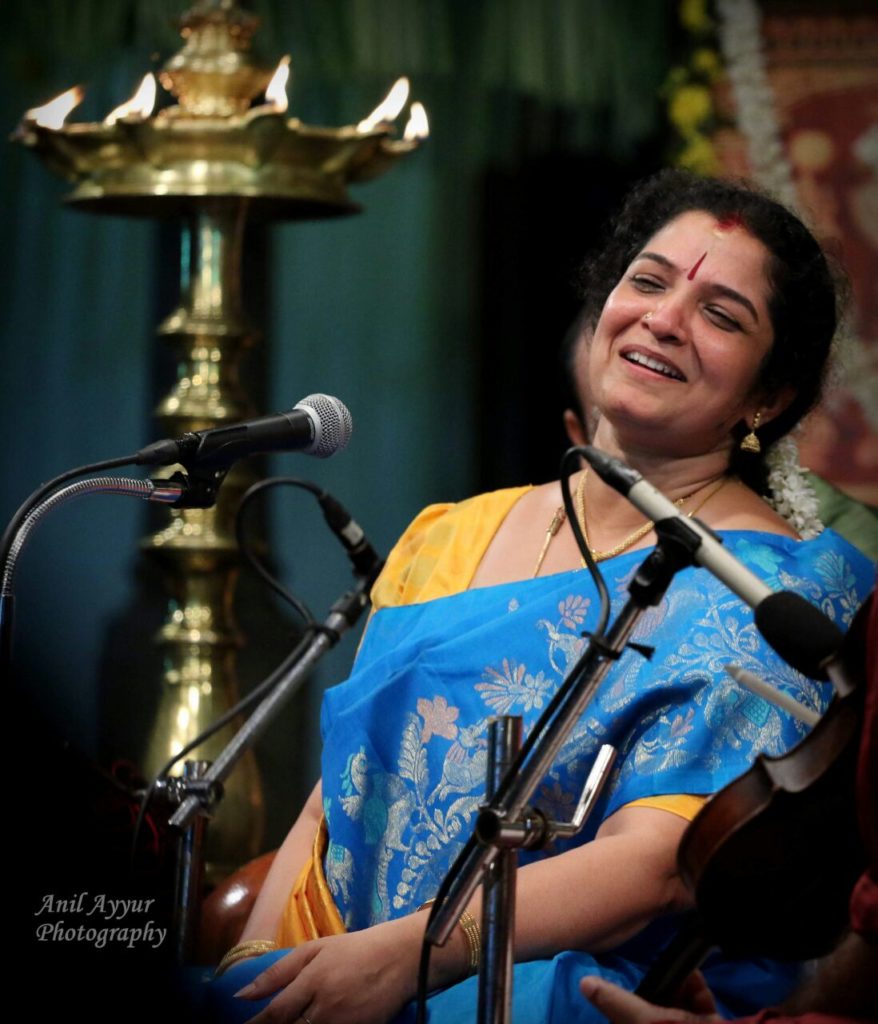G Baby Sreeram
A sparkling, confident on-stage persona and an approachable, cheerful demeanour characterise this lady, known for weighty classicism in vocal Carnatic music. A faculty member at The Music Academy’s Advanced School of Carnatic Music, there is a lot more to Dr. G Baby Sreeram than meets the eye. Augmented only periodically with expert guidance, her trajectory has been unconventional, with a large part of her learning from publicly available resources.
She grew up in a large, orthodox brahmin joint family in Trivandrum where the children alone numbered 11. Music was enmeshed in the fabric of the family’s life with practically every family member attuned to it and all local concerts attended. They were not well off. As she puts it, “Our family had music. But nothing else.” Her paternal grandfather, Bhagavathiswara Bhagavathar, and his ancestors, had been vidvAn-s at the Travancore court while her maternal grandfather had been a palace cook. Baby’s natural proclivity for music was found early and she was soon enrolled with a local mAmi for lessons. Even at the age of 7 or 8, she could elaborate rAgam-s correctly and well after merely hearing a phrase. However, a severe asthmatic (to the present day), being in and out of hospitals did not allow for regular classes. Her father insisted on listening to every Carnatic radio program. She followed Carnatic teaching lessons on the radio intently. “One kriti would be fully taught in two weeks.” Her uncle, working in All India Radio, would procure the notations. She learned many pieces in this manner. “I had to struggle to learn music, thanks to my health problems,” she says. From 8th Grade, she began teaching to supplement the household income.
Many thanks to Dr. G Baby Sreeram for locating vintage photographs and recording videos exclusively for this page. A version of this article appeared in The Hindu.
For about a year, one of her grandfather’s students, Ananthalakshmi Venkataraman, taught Baby some compositions. Baby’s elder sister learned violin at the Swatithirunal College of Music and would bring back the material to practice at home. Baby would learn it quickly herself and then help her sister. They would spend about 4 hours daily practicing each day’s lessons. “So many stalwart musicians like Harikesanallur Muthiah Bhagavathar, GN Balasubramaniam and Semmangudi Srinivasa Iyer had worked in that college and set an excellent syllabus with several varNam-s and heavy kriti-s”, she says. On the weekends, she would practice with Sekhar, a student of Vechoor Hariharasubramania Iyer. He taught her kriti-s like Dvaitamu sukhamA, Emi jesithe, I vasudhA, Kathanu vAriki and so on.

She participated in only one music competition (which she won) during college years, pressured by her classmates, her unusual pitch of 2.5 deemed ‘unsuitable’ by most decision makers. Baby graduated with a BA in Music in 1992 from Kerala University. The same year, she got the CCRT scholarship from the Indian Government impressing the judges Semmangudi Srinivasa Iyer and Guruvayur Dorai. She was asked if she would relocate to Chennai given her tremendous talent. She replied that if she received the scholarship, she would go. It was given to her on the spot with their suggestion that she learn from Sangita Kalanidhi TM Thiagarajan (TMT) in Chennai. At the age of 20, she was embarking on her first formal tutelage with a Guru.

She immediately moved to Chennai. With no family there, she stayed as a paying guest in several homes (“living in a hostel would not have allowed me to practice”) while taking lessons from TMT. She would go to TMT’s home in the morning (“he would give excellent notations – so good that one could sing the song directly from it”). “He would teach the pallavi and the anupallavi on the first day. I would write down the notation of the charanam too and sing the complete kriti the next day!” she recollects smilingly. She would then go to the Karpagambal Temple in Mylapore and practice whatever had been taught. After a simple lunch, she would spend the rest of the afternoon at the Sampradaya Library, then in Luz. “That library was such a treasure trove,” she says. “It had a most excellent collection of recordings archived by singer and concert that one could rewind and fast forward as much as we wanted.” She would select and notate at least two to three more songs daily from the library’s collection and learn those as well. When the library closed, she left to teach music to a few students to make ends meet. “I wanted to support myself. My family was struggling.” Sangeetha Sivakumar’s father had informed the library that Baby composed. Sampradaya asked her to perform a concert of only her compositions. That, in January 1993, was her maiden program in Chennai where she was accompanied by RK Shriramkumar on the violin and K Arunprakash on the mridangam.

Later that year, she performed for Nadopasana at Sastri Hall. “I used to attend concerts there practically daily. When asked, I mentioned I was TMT’s student. They then asked me to perform.” The following year, she won the All India Radio competition which gave her a Grade B certification. She had simultaneously also studied for the MA in Music from Kerala University by correspondence, graduating in 1994. Sangeetha Sivakumar asked her to meet Maitreyee Ramadurai who auditioned Baby right at the doorstep, resulting in Baby singing in the Spirit of Youth competition in 1996. She got the Best Performer award. (Unaware that the winner automatically gets a slot in the December season, she never applied for it. She sang for the first time at The Music Academy in 2012 at the 1.30 pm slot and remained at that slot until 2017 when she was moved to the first morning slot.) In 1997, AIR upgraded her to A Grade directly. “That felt like an anti-climax actually,” she states poignantly. “My greatest dream had been to get an A Grade. Once I actually received it, I was not sure what to do!” After the CCRT scholarship concluded, she learned from PS Narayanaswamy for about a year.
In 1995, she married Palakkad KL Sreeram, himself a musician and one proficient in many instruments. She started on her PhD, having got a Junior Research Fellowship – “The fellowship funds I received was more than the combined income of all the members of my family,” she says. She researched bhAshAnga rAgA-s (rAgA-s with additional notes not belonging to the identified parent rAgA). TMT had told her that many bhAshAnga rAgA-s had actually been upAnga rAgA-s earlier. They had probably been influenced by therukoothu, harikathA and kAlakshepam. Renditions often had to be heard over distances with little amplification, resulting in a lot of sanchArA-s in upper octaves. When emotional content had to be added, further elements were augmented “There are practically no rare bhAshAnga rAgA-s. They are almost always popular”. Baby extensively researched 44 bhAshAnga rAgA-s, exclusively through compositions of renowned vAgayekkArA-s and stalwart musicians. She notated 77 songs, culling the best through extensive listening. She explains how a rAgA can be expounded using those kriti-s as benchmarks. “A student can get a picture of the rAgA and learn compositions through my book,” she says. In 2004, she was awarded her doctorate from Kerala University.
Baby is known for her clear pronunciation, vivid imagination, clarity and thoughtful delineation of manodharma aspects. She attributes this to the artistes she grew up listening. These included Kerala based musicians such as vainikA R Venkataraman, flautist KS Gopalakrishnan, violinist K Venkatachalam, vocalists Parasala Ponnammal, Prabhakar Varma, Vechoor Hariharasubramania Iyer and more. Swati Tirunal Sangeetha Sabha and Navaratri Mandapam hosted all the leading artistes of the day from Chennai such as MD Ramanathan, Semmangudi Srinivasa Iyer, ML Vasanthakumari, DK Jayaraman, DK Pattammal and more. She adds here that music aspirants should engage in active, analytical listening. Since she did not have access to recordings, recording equipment or money, it was of utmost importance that she absorbed what was presented before her instantaneously, sometimes notating right there. “I would go back home, and try and learn those kriti-s, remembering the ‘moha bhAvam’” (facial expressions), she says. She was never taught manodharma sangeetham by any of her teachers and has never sung it before any of them either. Perhaps the teachers discerned her innate ability. TMT is known to have said that Baby and E Gayatri were the students of his with ‘karpoora budhdhi’ (sharp intellect).
Her favoured method to teach the structure of a rAgam to a student is to begin with a varNam in that raga. Then, she teaches several kriti-s in that one rAgA itself, going from simpler to more nuanced. That way, she says, the crux of the rAgA, its contours and characteristic phrases imprint themselves in the student’s mind. Taught this way, she opines that even similar sounding rAgam-s like PoornachandrikA and Janaranjani or MandhAri and Amritavarshini can be clearly distinguished. One should not go by ArohaNam and avarohaNam she says- that often provides a narrow view of the rAgA and can inhibit the thought process.
For kalpanAswaram-s, besides varnam-s, she suggests practicing varisai-s, particularly ‘dAttu varisai’ and progressive swarA combinations. This will ensure fluency, maintenance of swara sthAnA-s and free flow of the combinations whilst maintaining correct pronunciation.
RAgA AlApanA-s can and should be structured using songs of stalwart composers as a guide, she explains, which is why one should learn as many pieces as possible. The clues are all in the pieces themselves, she says. The opening phrase of any major kriti is a perfect opening to bring out the crux of the rAgA instantly. The charanam of kriti-s tells one how to delineate the lower sanchArA-s. The anupallavi is a roadmap for the upper notes and combining all the octaves provides yet another dimension.
Neraval is a real art and as with any art, how one gives vent to it can be very different. She likens it to how every painter might approach painting the same figure a different way – one might start with the face, the other might just draw out general proportions, a third might focus more on the ornamental aspects – similarly each artiste gives us different perspective. TMT told her to observe KV Narayanaswamy for his clarity in neraval combined with excellent sense of layA. She took inspiration from Semmangudi Srinivasa Iyer on how to fill in a line beautifully. Students would definitely find it helpful to be given pointers from a trained teacher for neraval for it can seem forbidding, she says. “Neraval is NOT just giving different tunes to a line,” she insists. “It is giving a different dimension of the rAgam to add to the essence of the lyric”.
The aesthetics of the music is of great importance to Baby. She explains how a plain sangathi is necessary to provide contrast and make the enhancement of the subsequent sangathi pop out. “One should also know where and what to abstain from. We should not sing something just because our throat is capable of it,” she says. She pays a lot of attention to the volume with which she delivers lyrics and phrases – “If I sing a phrase softly, it is because I intend it to be so.” She knows the word by word meaning of all the songs she sings, taking help from knowledgeable people as needed, and renders songs in a manner appropriate to the lyric. “In the SAranga piece Nee vAda ne gAna, the words ‘devAdi deva’ is referring to the Lord of Lords – it should be sung powerfully befitting the words. In the same song, the words ‘athyantha roopampu,’ meaning one with a beautiful appearance, should be sung softly and gently in line with its meaning. Every line should leave the listener with anticipation and wishing for more – they should have ‘ah’ or ‘aaha’ moments constantly,” she says.
Besides teaching at The Music Academy, Baby does not currently take in many students. “Most are not sufficiently committed to the art and they usually prefer popular artistes.” Her son, Bharath Narayan, a child prodigy and capable young singer, has always learned exclusively from her.
Baby has composed prolifically since the age of 8. She has done so in rare rAgA-s like ambAsri, KOmalANgi, cArukunTalam, amarasenapriyA and more. She has also composed kriti-s with swarAksharam (where notes and lyric syllables match), three swara jathi-s in the style of Shyama Shastri, ata tALa varnam-s, tillAnA-s etc. However, she has voluntarily not composed in the last ten years.
Baby has music on her mind during the entire day. She does the household chores, like laundry and cooking, singing all the while. It is when she teaches her son that she actually sits and sings. “I don’t worry too much about anything,” she says. “I don’t go seeking name or fame – rather, I should not lose what I have. I also firmly feel God will take care of things as needed.” This leaves Dr. Gurumoorthy Baby Sreeram mentally free to explore the depths of music.

Your notes on artistes are a treat to read and to archive as personal treasures. Thank you so much and keep them coming!
Warm Regards,
Lakshmi Mohan
Really proud Dear Friend, May The Lord bless you in splendid.
Excellent write up about a blessed artist.
Simplicity (Vinayam) marks this inspiring musician!
I am just awed to learn about the musical journey of GBaby Sreeram
.. from childhood till date . Such a knowledgeable person , down to earth and humble .. And her learning experiences be it at her home or later in chennai just leaves me touched . Taking notations and learning krithis .. not one but many .. is definitely great .
Her detailed explanation about raagam , Pallavi etc is so interesting.
Lucky are those who still learn from her . Proud of you .
Thanks for sharing
God bless
Thanks
God
Very happy to read about you and your journey as a musician GBaby Sriram. She is an humble and down to earth lady who inspired me a lot. God bless you.
Kudos baby I enjoyed evword of thewrite up. Simply supetb
Definitely students and experienced like me are inspired by baby,s musical journey and her deep ghnanam..neelaramgopal
Baby-ji, I am NOT commenting on u or anybody. I am 87, a descendant of a musical family of Sekharipuram, Palakkad with my thatha’s violin a Stradivarius 132 yrs old. My only audience all these decades were:1. the One Above 2.the Guru teaching me on that particular day(my akka 12yrs elder to me was my first); the poor guy, he/she, had no option BUT to listen since s/he had contracted to teaching me & was getting a small fee for it. Well, I am a strong opponent of ‘taalam’ for anyone like me who has no audience or co-player/singer/accompanist/group with me. After all, alaapana/shlokam/taanam…do not use taalam, so why at all a krithi should? I don’t care for some matha-pitha stuff either. I have heard millions of boys/girls sing film songs while in their shower. Absolutely divine, I tell u. They had NEVER EVER heard of such a monstrous thing as taalam; I learnt w.music for violin for 2 yrs first before I went back to my Akka for karnataka sangeetham which I had heard her practise for decades right from my birth (her lullabys to me!!). In W.style there are only 3 or 4 beats, no other! – not 35/175, nor sharabhanandanam….Shyama Shastri notwithstanding although I am an admirer of his Anandabhairavi and his immortal ‘himadrisuthe pahimam’ in Kalyani though my family’s traditions are all Dikshitar’s parampara. Now tell me why should we not encourage EVERYONE to enjoy singing/playing for his /her own aatmatripthi in his home with doors/windows closed but no taalam w/ever so no one will sue them? Thereby increase personal joy and pave his/her way to moksham. I am sure the One Above just does NOT care abt this horrible taalam Tyagaraja’s mokshamu galada’/naadaloludai notwithstanding. And, what more could one pray for?
What would be your views? Let all those who wish to make sangeetham their career learn thaalam + all those – like flute maali who were born with it in their blood. I have argued this with many of my gurus – only to draw an indulgent smile but they still taught me hundreds of varnams/krithis, regrettably forcing me into 2 or 3 kaalams. That practice on the violin certainly did benefit me in many ways including kalpanaswarams which sometimes my Akka learnt from me because before she could learn it from HER guru in Ooty, she was married off to a remote villager in Lalgudi district where there was not even a loo let alone a music teacher. Poor girl who had done her SSLC in Bethlehem Convent with lots of European girls in Ooty, the result: constipation! – because she could not bring herself to use open fields/farms of my athimber & the local stream or pond as toilet paper. That too I, being an expert in that art, had to teach her in the form of how to live with compulsions ordained by The One Above who only taught her how not to depend on ‘whisper…’ but on scraps of old podavais/blouses/towels…..
Such was our family – no riches; my thatha earned one rupee pm as a court clerk but 8 annas pm per student ( if he/she could afford it, if not, nil) for teaching violin 30 days a month!! Not Rs.500 – 1000/- pm as of today! Even I paid only Rs.35/- pm in Delhi, same at guruguhagana Vidyalaya, Cal back in 1965!
Bye. I just enjoyed sharing these thoughts with such a child-to-patti maestro! Forgive me if I have given cause to offend.
ramani 9953975275
Nothing more to use as appreciation…Hats off !!! A 1000 times… I was literally going behind baby sreeram mam.. Listening to her songs… Reading her notes …. Just because I am also a passionate music student who believes that from every small things we still have scope for learning…and my wish is to only learn learn till my end… Such a deep article woven in beautiful words …. Kudos to you for bringing her musical journey in front of a listener …..🙏🏻🙏🏻🙏🏻